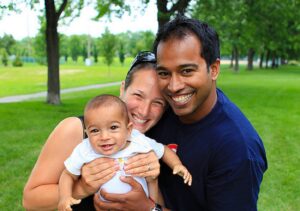Experts
Samantha Tornello
Assistant Professor of Human Development & Family Studies, Pennsylvania State University
News
- Mine and Yours, or Ours: Are All Egalitarian Relationships Equal?
 It turns out there is a big difference between dividing up the tasks so that each partner does different ones versus sharing or alternating the same tasks, so that partners contribute equally to each.
It turns out there is a big difference between dividing up the tasks so that each partner does different ones versus sharing or alternating the same tasks, so that partners contribute equally to each. - New MAST Center Brief on Trends in Relationship Formation and Stability
 The Marriage Strengthening Research & Dissemination Center (MAST) recently released a new research brief, “Trends in Relationship Formation and Stability in the United States: Dating, Cohabitation, Marriage, and Divorce.” Co-authored by CCF expert Dr. Karen… Read more: New MAST Center Brief on Trends in Relationship Formation and Stability
The Marriage Strengthening Research & Dissemination Center (MAST) recently released a new research brief, “Trends in Relationship Formation and Stability in the United States: Dating, Cohabitation, Marriage, and Divorce.” Co-authored by CCF expert Dr. Karen… Read more: New MAST Center Brief on Trends in Relationship Formation and Stability - Challenges Facing Cohabiting Couples Differ from those of Married Couples in this Crisis
 A briefing paper prepared by Amanda Miller, University of Indianapolis, and Sharon Sassler, Cornell University, for the Council on Contemporary Families. Much has been written about the challenges couples face as they adjust to “shelter… Read more: Challenges Facing Cohabiting Couples Differ from those of Married Couples in this Crisis
A briefing paper prepared by Amanda Miller, University of Indianapolis, and Sharon Sassler, Cornell University, for the Council on Contemporary Families. Much has been written about the challenges couples face as they adjust to “shelter… Read more: Challenges Facing Cohabiting Couples Differ from those of Married Couples in this Crisis - CCF’s Stephanie Coontz for The New York Times: What Can Different-Sex Couples Learn From Same-Sex Couples?
 Five years after marriage equality, CCF Director of Research and Public Education Stephanie Coontz asks: What can different-sex couples learn from same-sex couples? Featuring research by CCF experts Joanna Pepin, Dan Carlson, Virginia Rutter, Amanda Miller,… Read more: CCF’s Stephanie Coontz for The New York Times: What Can Different-Sex Couples Learn From Same-Sex Couples?
Five years after marriage equality, CCF Director of Research and Public Education Stephanie Coontz asks: What can different-sex couples learn from same-sex couples? Featuring research by CCF experts Joanna Pepin, Dan Carlson, Virginia Rutter, Amanda Miller,… Read more: CCF’s Stephanie Coontz for The New York Times: What Can Different-Sex Couples Learn From Same-Sex Couples? - National Spouses Day Is This Sunday…. Feeling Any Pressure?
 January 23, 2020 A fact sheet on prospects for marriage in contemporary America prepared for the Council on Contemporary Families by Daniel L. Carlson, University of Utah, and Stephanie Coontz, The Evergreen State College January… Read more: National Spouses Day Is This Sunday…. Feeling Any Pressure?
January 23, 2020 A fact sheet on prospects for marriage in contemporary America prepared for the Council on Contemporary Families by Daniel L. Carlson, University of Utah, and Stephanie Coontz, The Evergreen State College January… Read more: National Spouses Day Is This Sunday…. Feeling Any Pressure? - From Countercultural Trend to Strategy for the Financially Insecure: Premarital Cohabitation and Premarital Cohabitors, 1956-2015
 A briefing paper prepared for the Council on Contemporary Families by Arielle Kuperberg, Associate Professor of Sociology and Women and Gender Studies, UNC Greensboro. October 9, 2018 In the early 1960s, fewer than 3 percent… Read more: From Countercultural Trend to Strategy for the Financially Insecure: Premarital Cohabitation and Premarital Cohabitors, 1956-2015
A briefing paper prepared for the Council on Contemporary Families by Arielle Kuperberg, Associate Professor of Sociology and Women and Gender Studies, UNC Greensboro. October 9, 2018 In the early 1960s, fewer than 3 percent… Read more: From Countercultural Trend to Strategy for the Financially Insecure: Premarital Cohabitation and Premarital Cohabitors, 1956-2015 - Cohabitating Couples With Lower Education Levels Marry Less. Is This Because They Do Not Want To?
 A Research Brief Prepared for the University of Texas at Austin Population Research Center Research Brief Series Download a PDF of this Brief Kelly Raley Introduction Today, nearly two-thirds of first marriages are preceded by cohabitation,… Read more: Cohabitating Couples With Lower Education Levels Marry Less. Is This Because They Do Not Want To?
A Research Brief Prepared for the University of Texas at Austin Population Research Center Research Brief Series Download a PDF of this Brief Kelly Raley Introduction Today, nearly two-thirds of first marriages are preceded by cohabitation,… Read more: Cohabitating Couples With Lower Education Levels Marry Less. Is This Because They Do Not Want To? - Josh Coleman and Barbara Risman weigh-in on the nation’s obsession with other peoples’ romances
 In his New York Times opinion piece, Americans Put Too Much Weight in Romantic Love, CCF Board member Josh Colemen comments on the nation’s obsession with romantic relationships – reflecting on examples from the Clinton presidency and referencing fellow CCF-er Barbara Risman along… Read more: Josh Coleman and Barbara Risman weigh-in on the nation’s obsession with other peoples’ romances
In his New York Times opinion piece, Americans Put Too Much Weight in Romantic Love, CCF Board member Josh Colemen comments on the nation’s obsession with romantic relationships – reflecting on examples from the Clinton presidency and referencing fellow CCF-er Barbara Risman along… Read more: Josh Coleman and Barbara Risman weigh-in on the nation’s obsession with other peoples’ romances - What Happens When Couples Marry after the First Baby?
 What Happens When Couples Marry after the First Baby? A briefing paper prepared for the Council on Contemporary Families by Kelly Musick, Cornell University and Katherine Michelmore, University of Michigan September 16, 2015 One… Read more: What Happens When Couples Marry after the First Baby?
What Happens When Couples Marry after the First Baby? A briefing paper prepared for the Council on Contemporary Families by Kelly Musick, Cornell University and Katherine Michelmore, University of Michigan September 16, 2015 One… Read more: What Happens When Couples Marry after the First Baby? - The Tricky Business of Sorting Out Sexual Assault: An Introduction to The CCF Symposium On Intimate Partner Violence
 THE TRICKY BUSINESS OF SORTING OUT SEXUAL ASSAULT: AN INTRODUCTION TO THE CCF SYMPOSIUM ON INTIMATE VIOLENCE by Stephanie Coontz , Director of Research and Public Education, Council on Contemporary Families, and Faculty Member in History,… Read more: The Tricky Business of Sorting Out Sexual Assault: An Introduction to The CCF Symposium On Intimate Partner Violence
THE TRICKY BUSINESS OF SORTING OUT SEXUAL ASSAULT: AN INTRODUCTION TO THE CCF SYMPOSIUM ON INTIMATE VIOLENCE by Stephanie Coontz , Director of Research and Public Education, Council on Contemporary Families, and Faculty Member in History,… Read more: The Tricky Business of Sorting Out Sexual Assault: An Introduction to The CCF Symposium On Intimate Partner Violence - Marriage, Divorce, and Remarriage Matter to Americans (and Data Matters, Too)
 American families are diversifying in ways that are more complicated than ever, creating distinct patterns in different parts of the country and subgroups of the population. That’s why policy-makers and community leaders need detailed, locally-specific census data about family formation, marriage trends, divorce, and widowhood. This information is essential in order to accurately assess everything from population growth patterns to the special educational and social needs of different neighborhoods. Yet the Census Bureau has announced plans to cut from the American Community Survey several questions that provide such crucial information to researchers, planners, journalists, and the general public.
American families are diversifying in ways that are more complicated than ever, creating distinct patterns in different parts of the country and subgroups of the population. That’s why policy-makers and community leaders need detailed, locally-specific census data about family formation, marriage trends, divorce, and widowhood. This information is essential in order to accurately assess everything from population growth patterns to the special educational and social needs of different neighborhoods. Yet the Census Bureau has announced plans to cut from the American Community Survey several questions that provide such crucial information to researchers, planners, journalists, and the general public. - Overview: Family Trends You Might Not Have Expected
 October 12 marks the 4th anniversary the United States becoming a “no-fault nation.” On that date in 2010, New York, the last holdout, finally joined the 49 other states in eliminating the need for divorcing couples to state that the dissolution of their marriage was the “fault” of one or the other. Today, every state offers the possibility of a no-fault divorce. Three years later, the co-chair of The Coalition for Divorce Reform claims that “no-fault divorce has been a disaster,” leading to record numbers of divorces and plummeting rates of marriage. Figuring out divorce and marriage trends is further complicated by the recent foreclosure crisis and the ensuing deep recession. The Council on Contemporary Families asked five researchers to explore recent trends in divorce and marriage for the CCF Symposium on New Inequalities.
October 12 marks the 4th anniversary the United States becoming a “no-fault nation.” On that date in 2010, New York, the last holdout, finally joined the 49 other states in eliminating the need for divorcing couples to state that the dissolution of their marriage was the “fault” of one or the other. Today, every state offers the possibility of a no-fault divorce. Three years later, the co-chair of The Coalition for Divorce Reform claims that “no-fault divorce has been a disaster,” leading to record numbers of divorces and plummeting rates of marriage. Figuring out divorce and marriage trends is further complicated by the recent foreclosure crisis and the ensuing deep recession. The Council on Contemporary Families asked five researchers to explore recent trends in divorce and marriage for the CCF Symposium on New Inequalities. - A Class Act? Stability and Instability in Children’s Lives
 Contrary to popular opinion, growing instability in American families, reflected not just in divorce rates but falling rates of marriage and high rates of unwed motherhood, is not caused by people abandoning traditional concerns for children’s well-being. It is a class issue caused by the growing gap between the job options, resources, economic stability, and personal safety nets available to college-educated Americans and less-educated workers. The authors explain.
Contrary to popular opinion, growing instability in American families, reflected not just in divorce rates but falling rates of marriage and high rates of unwed motherhood, is not caused by people abandoning traditional concerns for children’s well-being. It is a class issue caused by the growing gap between the job options, resources, economic stability, and personal safety nets available to college-educated Americans and less-educated workers. The authors explain. - Gray Divorce: A Growing Risk Regardless of Class or Education
 In contrast to the seeming stabilization of divorce rates for the general population over the past two decades, the gray divorce rate has doubled: Married individuals aged 50 and older, including the college-educated, are twice as likely to experience a divorce today as they were in 1990. For married individuals aged 65 and older, the risk of divorce has more than doubled since 1990. Researchers explain why.
In contrast to the seeming stabilization of divorce rates for the general population over the past two decades, the gray divorce rate has doubled: Married individuals aged 50 and older, including the college-educated, are twice as likely to experience a divorce today as they were in 1990. For married individuals aged 65 and older, the risk of divorce has more than doubled since 1990. Researchers explain why. - Divorce and the Recession
 It is quite likely that the economic crisis both caused some divorces and prevented some divorces. However, the balance of the evidence suggests it prevented more than it caused. I would not read this as good news for marriage and families, however, because there may be negative consequences for people who want to part but cannot divorce because of economic constraints. The enforced wait could simply prolong or exacerbate marital stress and family conflict, rather than saving or restoring a happy marriage.
It is quite likely that the economic crisis both caused some divorces and prevented some divorces. However, the balance of the evidence suggests it prevented more than it caused. I would not read this as good news for marriage and families, however, because there may be negative consequences for people who want to part but cannot divorce because of economic constraints. The enforced wait could simply prolong or exacerbate marital stress and family conflict, rather than saving or restoring a happy marriage. - CCF Civil Rights Symposium: Fifty Years of Religious Change: 1964-2014
 In 1964 the provisions outlawing discrimination on the basis of religion were less controversial than those against discrimination on the basis of race and sex, even though blatant bigotry and outright violence against Catholics and Jews had been pervasive in American history right up through World War II. Prejudices had begun to ease by the early 1960s, but the Civil Rights Act remains an important safeguard for religious (and non-religious) minorities, according to Jerry Z. Park, Joshua Tom and Brita Andercheck, of Baylor University.
In 1964 the provisions outlawing discrimination on the basis of religion were less controversial than those against discrimination on the basis of race and sex, even though blatant bigotry and outright violence against Catholics and Jews had been pervasive in American history right up through World War II. Prejudices had begun to ease by the early 1960s, but the Civil Rights Act remains an important safeguard for religious (and non-religious) minorities, according to Jerry Z. Park, Joshua Tom and Brita Andercheck, of Baylor University. - Red states, blue states, and divorce: Understanding the impact of conservative protestantism on regional variation in divorce rates
 Why are divorce rates higher in religiously conservative “red” states and lower in less religiously conservative “blue” states? After all, most conservatives frown upon divorce, and religious commitment is believed to strengthen marriage, not erode it. Even so, religiously conservative states Alabama and Arkansas have the second and third highest divorce rates in the U.S., at 13 per 1000 people per year while New Jersey and Massachusetts, more liberal states, are two of the lowest at 6 and 7 per 1000 people per year.
Why are divorce rates higher in religiously conservative “red” states and lower in less religiously conservative “blue” states? After all, most conservatives frown upon divorce, and religious commitment is believed to strengthen marriage, not erode it. Even so, religiously conservative states Alabama and Arkansas have the second and third highest divorce rates in the U.S., at 13 per 1000 people per year while New Jersey and Massachusetts, more liberal states, are two of the lowest at 6 and 7 per 1000 people per year. - Family structure, race, education and economic inequalityCFF’s board members, Stephanie Coontz and Phil Cohen discuss the relationship between family structure, race, education and economic inequality in a Washington post article.
- Women’s Education and their Likelihood of Marriage: A Historic Reversal
 By Paula England Professor of Sociology New York University Email: pengland@nyu.edu Phone 650-815-9308 Jonathan Bearak Ph.D. Candidate New York University Email: jonathan.bearak@nyu.edu Download Full Report as a PDF Download Full Report as a Word Document… Read more: Women’s Education and their Likelihood of Marriage: A Historic Reversal
By Paula England Professor of Sociology New York University Email: pengland@nyu.edu Phone 650-815-9308 Jonathan Bearak Ph.D. Candidate New York University Email: jonathan.bearak@nyu.edu Download Full Report as a PDF Download Full Report as a Word Document… Read more: Women’s Education and their Likelihood of Marriage: A Historic Reversal - Women’s Education and Their Likelihood of Marriage: A Historical ReversalFor most of the 20th century, women who completed higher education were far less likely to be married than their less-educated counterparts. Then in 2010, the Council on Contemporary Families (CCF) reported new research showing that although college-educated women were still more likely to never marry at all than women with lower educational levels, they were so much less likely to divorce that by age 40, a higher proportion of college-educated women were married than any other group.
- Is That a Fact? Three Brief Reports on the Credibility of Facts
 Americans are bombarded by a constant stream of competing factoids and causal claims about families. Politicians, advocacy groups, pundits, and instant internet “experts” claim that social science “proves” this or that is the impact of divorce, “surveys show” what people think about marriage, or “the facts are clear” about the benefits of one family form or another. Are some facts more trustworthy than others, and if so, how can we tell the trustworthy from the untrustworthy? What is the difference between a cause, a correlation and a coincidence?
Americans are bombarded by a constant stream of competing factoids and causal claims about families. Politicians, advocacy groups, pundits, and instant internet “experts” claim that social science “proves” this or that is the impact of divorce, “surveys show” what people think about marriage, or “the facts are clear” about the benefits of one family form or another. Are some facts more trustworthy than others, and if so, how can we tell the trustworthy from the untrustworthy? What is the difference between a cause, a correlation and a coincidence? - Are Individuals Who Marry at an Older Age Too Set in Their Ways to Make Their Marriages Work?
 Research on marriage trends suggests a U- shaped pattern of marital stability: marriages contracted in the early to mid twenties had lower divorce rates than those taking place before or after those ages. Do the patterns of the 1960s hold today? If they do, the present trend towards increasingly older ages at entry into marriage would be expected to be accompanied by higher levels of marital instability. This study examines this question, with particular focus on the case of women.
Research on marriage trends suggests a U- shaped pattern of marital stability: marriages contracted in the early to mid twenties had lower divorce rates than those taking place before or after those ages. Do the patterns of the 1960s hold today? If they do, the present trend towards increasingly older ages at entry into marriage would be expected to be accompanied by higher levels of marital instability. This study examines this question, with particular focus on the case of women. - How Should We Think About the Taxpayer Consequences of Divorce?
 A new report, “The Taxpayer Costs of Divorce and Unwed Childbearing: First-Ever Estimates for the Nation and all 50 States”, raises the question of how much divorce costs taxpayers. This is an intriguing question, but… Read more: How Should We Think About the Taxpayer Consequences of Divorce?
A new report, “The Taxpayer Costs of Divorce and Unwed Childbearing: First-Ever Estimates for the Nation and all 50 States”, raises the question of how much divorce costs taxpayers. This is an intriguing question, but… Read more: How Should We Think About the Taxpayer Consequences of Divorce? - Understanding Low-Income Unmarried Couples with Children
 Download Full Report as a PDF Download Full Report as a Word Document Why do so many low-income couples postpone marriage but fail to postpone childbearing? Which couples eventually do marry? Why do the rest… Read more: Understanding Low-Income Unmarried Couples with Children
Download Full Report as a PDF Download Full Report as a Word Document Why do so many low-income couples postpone marriage but fail to postpone childbearing? Which couples eventually do marry? Why do the rest… Read more: Understanding Low-Income Unmarried Couples with Children - The Impact of Divorce on Children’s Behavior Problems
 Download Full Report as a PDF Download Full Report as a Word Document This paper summarizes the argument and findings of a longer and more technical paper that won the 2007 Graduate Student Paper Award… Read more: The Impact of Divorce on Children’s Behavior Problems
Download Full Report as a PDF Download Full Report as a Word Document This paper summarizes the argument and findings of a longer and more technical paper that won the 2007 Graduate Student Paper Award… Read more: The Impact of Divorce on Children’s Behavior Problems - Tricky Business of Estimating Divorce
 In a research brief from the Council on Contemporary Families, University of Chicago’s Patrick Heuveline explains how divorce rates get calculated. If you ever report on divorce rates, this article will give you confidence in how you interpret them, and will show you the key questions to ask your sources when they are reporting on divorce statistics.
In a research brief from the Council on Contemporary Families, University of Chicago’s Patrick Heuveline explains how divorce rates get calculated. If you ever report on divorce rates, this article will give you confidence in how you interpret them, and will show you the key questions to ask your sources when they are reporting on divorce statistics. - Will Providing Marriage Rights To Same-Sex Couples Undermine Heterosexual Marriage? Evidence From Scandinavia
 Download Full Report as a PDF Download Full Report as a Word Document By M. V. Lee Badgett Professor of Economics University of Massachusetts, Amherst As a way to understand what might happen, some writers… Read more: Will Providing Marriage Rights To Same-Sex Couples Undermine Heterosexual Marriage? Evidence From Scandinavia
Download Full Report as a PDF Download Full Report as a Word Document By M. V. Lee Badgett Professor of Economics University of Massachusetts, Amherst As a way to understand what might happen, some writers… Read more: Will Providing Marriage Rights To Same-Sex Couples Undermine Heterosexual Marriage? Evidence From Scandinavia
